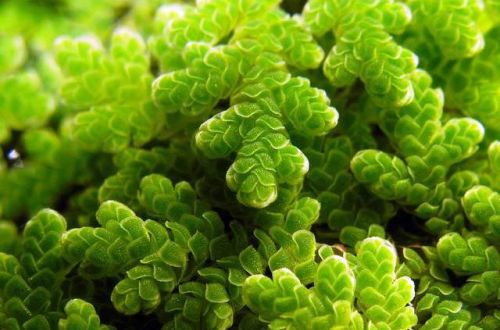
Anubias Nana
Anubias dwarf or Anubias Nana, scientific name Anubias barteri var. Nana. It is one of the natural varieties of Anubias Barter. Comes from Cameroon (Africa). It has been successfully cultivated as an aquarium plant since the 1970s. It has gained wide popularity around the world due to its amazing hardiness and stamina, which is why it is called the “plastic plant”.
Anubias Nana is considered one of the most unpretentious plants for the aquarium. Not picky about the level of lighting, grows successfully even with a lack of nutrients.
However, Anubias pygmy gets its best spring appearance on a nutrient-rich substrate with an additional introduction of carbon dioxide. Removing old leaves promotes the growth of young leaves.
It is worth noting that even under favorable conditions, Anubias grow very slowly, which is why dotted algae (Xenococus) often appear on the leaves. The algae problem is exacerbated in bright light. High levels of phosphates (1,5-2 mg/l) combined with a good supply of iron and trace elements reduce the number of spot algae on plants exposed to bright light.
Another way to deal with spot algae is to place Anubias Nana in a shaded area of the aquarium.
Reproduction of this plant is carried out by simply dividing the rhizome into two or more parts.
Such a miniature plant, forming bushes only 10-20 cm in size, is recommended for use in aquariums in the foreground. In small tanks (nano aquariums) they are placed in the central part. When planting, the rhizome should be located on top of the substrate, it should not be immersed in the ground, otherwise the roots will rot. It is desirable to use coarse sand or small pebbles as a substrate.
Anubias Nana is suitable for decorating other elements of the aquarium. Its strong developed bark system allows the plant to establish itself on hard surfaces such as driftwood and rough stones. For reliability, they are additionally fastened with nylon threads (ordinary fishing line).
In nature, Anubias grow mainly in moist, damp places near the water’s edge, and not under water, so they are also an important element in the design of paludriums. It is in the air at high humidity that flowers can appear.
Basic information:
- Difficulty of growing – simple
- Growth rates are low
- Temperature — 12-30°С
- Value pH — 6.0–8.0
- Water hardness – 1-20GH
- Illumination level – any
- Use in an aquarium – foreground and middle ground
- Suitability for a small aquarium – yes
- spawning plant – no
- Able to grow on snags, stones – yes
- Able to grow among herbivorous fish – yes
- Suitable for paludariums – yes




